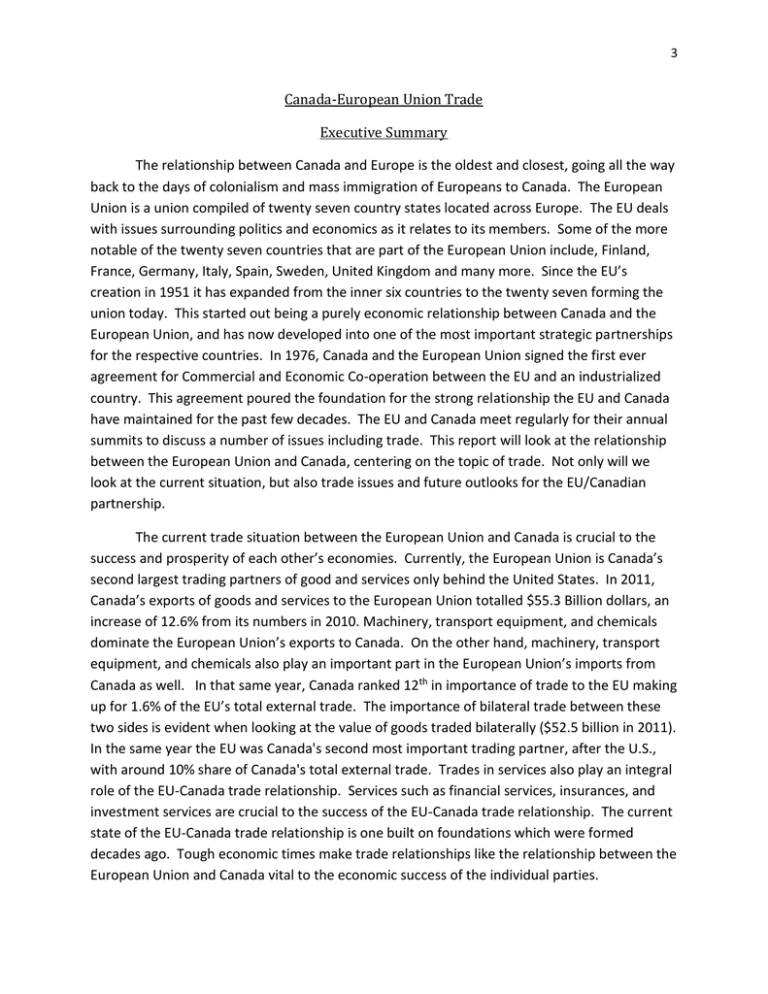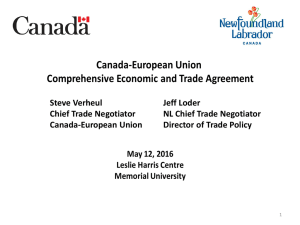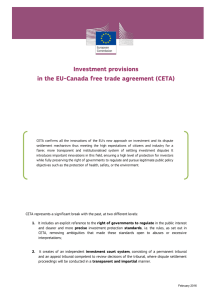Canada-European UnionTrade
advertisement

3 Canada-European Union Trade Executive Summary The relationship between Canada and Europe is the oldest and closest, going all the way back to the days of colonialism and mass immigration of Europeans to Canada. The European Union is a union compiled of twenty seven country states located across Europe. The EU deals with issues surrounding politics and economics as it relates to its members. Some of the more notable of the twenty seven countries that are part of the European Union include, Finland, France, Germany, Italy, Spain, Sweden, United Kingdom and many more. Since the EU’s creation in 1951 it has expanded from the inner six countries to the twenty seven forming the union today. This started out being a purely economic relationship between Canada and the European Union, and has now developed into one of the most important strategic partnerships for the respective countries. In 1976, Canada and the European Union signed the first ever agreement for Commercial and Economic Co-operation between the EU and an industrialized country. This agreement poured the foundation for the strong relationship the EU and Canada have maintained for the past few decades. The EU and Canada meet regularly for their annual summits to discuss a number of issues including trade. This report will look at the relationship between the European Union and Canada, centering on the topic of trade. Not only will we look at the current situation, but also trade issues and future outlooks for the EU/Canadian partnership. The current trade situation between the European Union and Canada is crucial to the success and prosperity of each other’s economies. Currently, the European Union is Canada’s second largest trading partners of good and services only behind the United States. In 2011, Canada’s exports of goods and services to the European Union totalled $55.3 Billion dollars, an increase of 12.6% from its numbers in 2010. Machinery, transport equipment, and chemicals dominate the European Union’s exports to Canada. On the other hand, machinery, transport equipment, and chemicals also play an important part in the European Union’s imports from Canada as well. In that same year, Canada ranked 12th in importance of trade to the EU making up for 1.6% of the EU’s total external trade. The importance of bilateral trade between these two sides is evident when looking at the value of goods traded bilaterally ($52.5 billion in 2011). In the same year the EU was Canada's second most important trading partner, after the U.S., with around 10% share of Canada's total external trade. Trades in services also play an integral role of the EU-Canada trade relationship. Services such as financial services, insurances, and investment services are crucial to the success of the EU-Canada trade relationship. The current state of the EU-Canada trade relationship is one built on foundations which were formed decades ago. Tough economic times make trade relationships like the relationship between the European Union and Canada vital to the economic success of the individual parties. 3 With every partnership or relationship there are always issues between both sides. The same can be said for the relationship of trade between Canada and the European Union. Trade issues between the two sides include topics such as, agriculture, automobiles, government procurement, and intellectual property. When it comes to agriculture there are tariff and nontariff barriers in the agri-food sector, both in Canada and in the European Union. The elimination of those barriers would, in the long run, boost Canadian exports.The EU is concerned about Genetically Modified Organisms (GMOs), and about fish and seafood. Massive imports of fish and seafood products from Canada could threaten the European industry. The EU would also like to protect certain agricultural products that are subject to high duties, such as beef and pork products, and grains.The problem is that these are export markets that Canada hopes to develop. The second trade issue between the EU and Canada focuses on automobiles. The European Union wants a high number of automobiles (tariff free) in exchange for access to the European Market. The problem for Canada is the high number is almost impossible to meet. The third issue of trade involves money and government procurement. The European Union and Canada are unable to resolve this issue because the EU wants more concessions when it comes to energy and transportation and Canada is unwilling to budge on their wishes. With this being said both sides will have to work together on this part of the agreement to ensure both sides are happy with the end result. This could take some time as both sides seem to be at separate ends of the procurement issue. The final trade issue focuses on intellectual property and intellectual property rights. The goal is to protect copyright, trademarks and any other intellectual properties. The hope is that an agreement can be reached in order to enforce property rights such as theft, piracy or the trade of counterfeit goods. These goods can include movies, music or games that have been bootlegged or shared over online networks, generic medicines and other pharmaceuticals destined for developing countries, and other patentable or certifiable goods. If European companies want to do business in Canada, they need to rely on the protection of their patents, trademarks, designs, copyrights or geographical indications. The resolution of these trade issues surrounding the EU and Canada will only be achieved through tough negotiations and some give between both sides. The hard work to surpass these issues will surely lead to greater prosperity and an even stronger trade relationship between the two sides. The relationship between the European Union and Canada is one with very bright outlooks for the future. Currently, the EU and Canada are negotiating an economic and trade agreement with one another that would see intellectual property protected during trade. First launched in 2009, the Canada European Union Comprehensive and Economic Trade Agreement (CETA). This agreement has been tabbed as the next generation in agreements as it looks at the global economic changes that have occurred in the global economy for decades. Negotiators have made significant strides in the agreement and it is expected the agreement will be finalized in 2012. With the globalization of production chains in the economy, companies have 3 taken their products across multiple borders in order to produce them and keep the costs low. Along with multilateral processes, Canada and the EU are also working bilaterally to increase Canada-EU economic integration. According to the Canadian Trade Commissioners Service the growth as a result of CETA is projected as follows, a $12.6 billion (20.6%) increase in Canadian goods and services exports to the EU within seven years of implementation of an agreement, three-quarters of which would be goods and one-quarter would be services.An increase of total bilateral trade in goods and services by $38 billion (22.9%) within seven years of implementation of an agreement.13 areas of cooperation where there is further scope for closer cooperation between Canada and the EU, including science and technology, regulatory cooperation, competition, transport, customs, education and fisheries.With this being said it is essential for trade agreements in today’s world to be surrounded around the protection of the intellectual property, investment, and the movement of skilled workers. With the ever changing times, the hope is that CETA will protect the economic trade problems of the future before it is too late to do so. The trade relationship between the European Union and Canada is one that will continue to improve and strengthen over time. With the ever developing world it is critical that agreements such as CETA are formed in order to keep the integrity of trade relationships between countries. The European Union and Canada are one of the closest partnerships in modern times. This lengthy partnership will only continue to become even closer and more integrated with the handling of the economic opportunities of the future. The hope is that outstanding trade issues can be resolved and trade between the EU and Canada can operate fluently and efficiently. With the focus of achieving success and prosperity through this trade relationship, both parties can learn from the past, deal with the current trade situation at hand and look forward to handling the decisions of future opportunities as allies.








